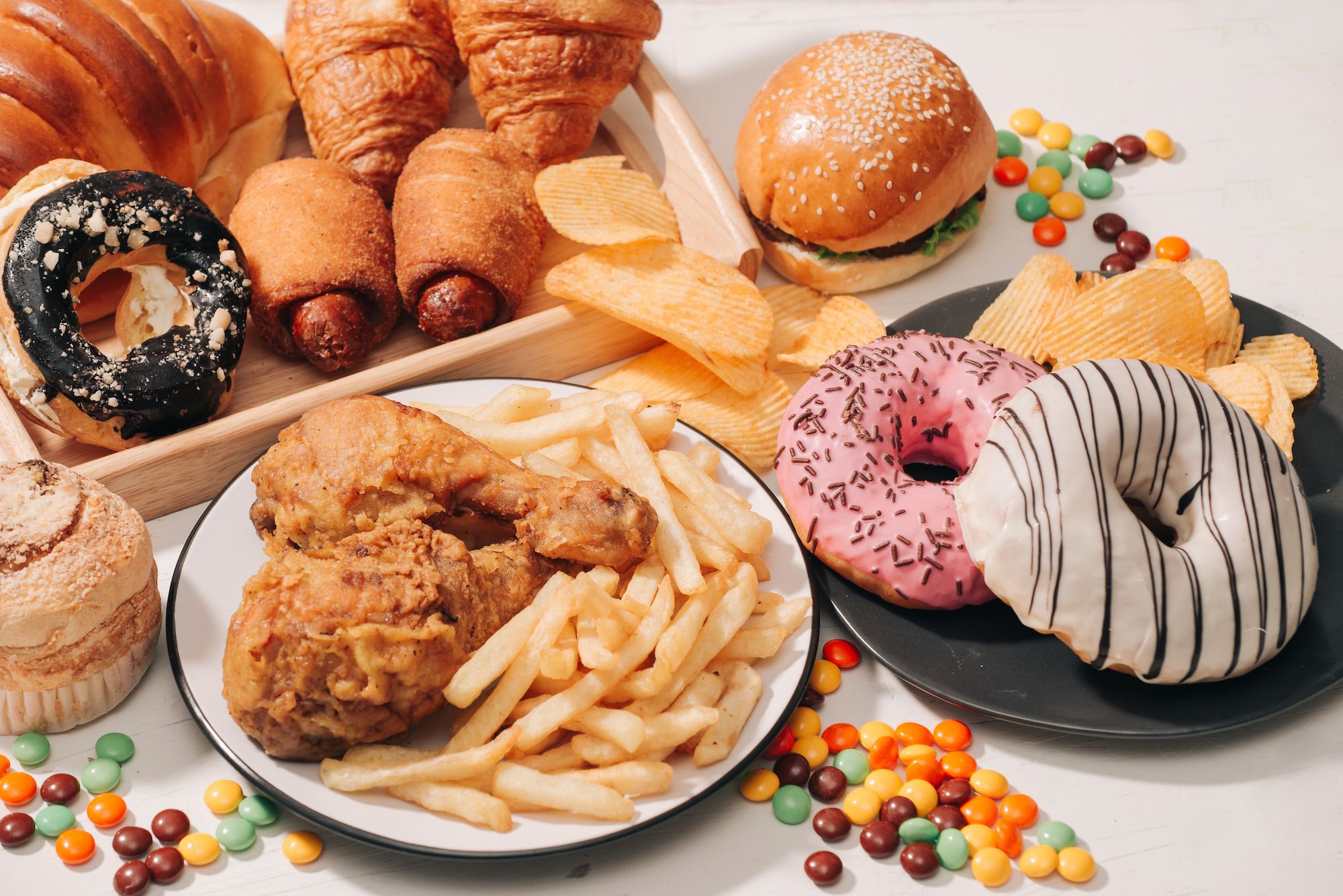LISTEN TO THIS ARTICLE:
In 1963, Lay’s created the slogan, “betcha can’t eat just one” in reference to the highly addictive nature of eating their salty potato chips. Although a clever campaign, the underlying message is both accurate and alarming. A recently published report outlining the results of a July 2022 survey conducted by the University of Michigan National Poll on Healthy Aging highlights this concern. The researchers polled a nationally representative sample of adults ages 50 – 80 regarding symptoms of processed food addiction. They explored the link between these symptoms in relation to the mental and physical health of the participants. The survey concluded that approximately 1 in 8 adults (13%) met criteria for an addiction to processed food. These include products that have high levels of ingredients like fat and refined carbohydrates, such as added sugar.
What is food addiction?
The criteria was established by a modified version of the Yale Food Addiction Scale, which outlines 11 symptoms in addition to measures of impairment or distress. The scale focuses on identifying problems associated with food. These issues interfere with a person’s daily routine, work or school productivity, relationships, and health. In order to meet criteria for an addiction to processed food, adults had 2 or more of the 11 symptoms plus signs of significant impairment or distress.
Among older adults meeting criteria for processed food addiction, 12% reported that their eating behaviors caused them great distress at least 2-3 times per week. Additionally, approximately 1 in 10 respondents cited significant issues occurring at least 2 -3 times per week as a result of their intake of highly processed foods. The report also made key comparisons about gender. Women were more than twice as likely as men to meet the criteria with 18% of females versus 8% of males. Women ages 50-64 were most impacted by processed food addiction as 22% of this group met the criteria.

Symptoms of processed food addiction
It is important to note that even though not all of the respondents met the established criteria for processed food addiction, almost half of those surveyed were still negatively affected. Notably, 44% of respondents indicated one or more symptoms of addiction to processed food. The most common symptoms reported were intense cravings, inability to reduce consumption despite wanting to, and signs of withdrawal. Signs of withdrawal include irritability, an inability to concentrate, and headaches.
One of the prominent symptoms of processed food addiction is compulsive eating, which stems from feeling a loss of control. This lack of control around food can interfere with daily responsibilities, such as taking care of a family member, or even put someone in a dangerous situation, such as distracted driving. People may avoid work or school and eat to the point where they become physically ill. These types of behaviors are consistent with substance-use disorders. Individuals who show signs of addictive-like eating tend to show characteristics such as impulsivity, difficulty regulating emotions, and dopamine signaling dysfunction.
Brain chemistry drives the problems
Highly processed foods release the neurotransmitter dopamine. Dopamine is a chemical messenger that provides the brain and body with intense feelings of reward and pleasure. The reward feeling from eating foods high in fat and refined carbohydrates is powerful. The levels of dopamine released are similar to the amounts released by nicotine and alcohol. Processed foods can increase dopamine by 150 – 200%.
The term abuse liability has been used to describe how addictive a drug might be to someone. Some experts have begun to talk about certain foods in terms of their abuse liability, or their potential to become addictive. Highly processed foods have a unique combination of refined carbohydrates, like added sugar, and fat. It’s this combination that has a synergistic effect. This means that the ingredients work together to produce a stronger effect on the brain’s reward system than a food that has only one or no additives. High fat and high sugar foods have a higher abuse liability potential and are more likely to trigger addictive eating. This “super response” happens even when people are full.
Processed food addiction and mental health
The University of Michigan research highlighted the relationship between processed food addiction and mental health. Older adults who self-reported their mental health as fair or poor were 3 times more likely to meet the Yale Food Addiction Scale criteria compared to those who reported good, very good, or excellent mental health. Moreover, processed food addiction was associated with feelings of isolation from others. Half of women and 26% of men who reported feeling isolated also met criteria for processed food addiction.
These statistics raise a “chicken or the egg” type question: Does addiction to highly processed foods lead to poor mental health or does poor mental health increase the likelihood of addiction to processed foods? The answer is difficult to parse out; however, it is likely that both influence the other. Individuals with some mental health conditions, like depression, have altered dopamine signaling. While this is not the sole cause of depression, it is one of many factors that play a contributing role. Thus, these people may be more likely to seek experiences that release dopamine, like consuming unhealthy food, in order to feel pleasure or help cope with negative emotions.
Eating processed foods can severely damage the gut microbiome, leading to chronic levels of inflammation. Recent promising research about the gut-brain connection suggests this as a major contributing factor to many mental health conditions. Whether a person with poor mental health is more likely to become addicted to processed foods or a person who becomes addicted to processed food develops poor mental health, the result is the same. Similar to taking drugs, people get caught in a cycle. Uncontrollable, short-term pleasurable experiences lead to, or increase, significant negative mental health effects.
Processed food addiction and chronic disease: A public health crisis
High levels of inflammation caused by processed foods are also linked to the development of chronic disease. Nutrient-poor diets that are high in fat and refined carbohydrates are a significant contributor to type 2 diabetes, heart disease, and many types of cancer. These conditions are known as non-communicable diseases (NCDs). That means they are not caused by an acute infection; rather, they are long-term and progressive. They are the leading causes of preventable death around the globe. Over the past 50 years, rates of these diseases have risen sharply. Sadly, NCDs account for 72% of all deaths.
Personal responsibility or purposeful for profit?
Although individuals are often blamed for their food choices, citing “personal responsibility” for processed food addiction does not tell the full story. Highly processed foods are less expensive than minimally processed, nutrient-dense foods. This is due to the use of cheap but very strong industrial substances such as high fructose corn syrup, a type of artificial sugar, and trans fat. Seventy-four percent of items in grocery stores contain sugar added by the food industry. These items cost less per serving than healthier alternatives.
In 2019, more than 35 million Americans were food insecure. This means they were unable to meet their nutritional needs due to high cost or an inability to access healthy food options. According to the United States Department of Agriculture (USDA), approximately 19 million people in the US live in a food desert. Food deserts are areas where residents have little to no options of buying affordable and healthy food. The Covid-19 pandemic made the situation even more dire.
Moreover, the goal of marketing campaigns is to establish brand loyalty of consumers through positive associations with the product. Oftentimes, these brands target children with the hope of creating life-long customers. Cue the cereal aisle: “Silly Rabbit, Trix are for kids!” I still have feelings of nostalgia every time I see a box of Cinnamon Toast Crunch. In the United States, the food industry spends $1.4 billion dollars per year on advertisements targeting children. More than 80% of these marketing strategies promote fast food, sugar-filled drinks, and candy. Food companies know what they are doing. Their goal is clear: Sell as much product as possible regardless of the detrimental physical and mental health effects on consumers.
Preventing processed food addiction
Over $1.1 billion per year is spent on marketing unhealthy food to children. Compare that to the CDC’s $1.4 million dollar budget for chronic disease prevention and health promotion. Furthermore, 75% of all US healthcare dollars go to attempting to treat preventable, chronic diseases. The numbers don’t add up. This reactive versus proactive approach is only making people sicker. In order to decrease processed food addiction and its resulting health effects, the key is prevention.
Over the last 30 years, education on healthy food choices has done little to decrease rates of obesity and chronic disease. Due to the highly addictive nature of processed food, this isn’t surprising. Education alone has not been effective in reducing the use of other abused substances. While education is important, it must be implemented in combination with other preventive measures. These include healthcare screenings, access to nutritious food, and industry accountability. Annual screenings by primary care providers using research-based tools, such as the Yale Food Addiction Scale, are the best way to assess for the risk or presence of processed food addiction. Subsequent resources, such as a referral to a mental health professional or nutritionist, for follow-up treatment is essential.
Getting people good food
Healthy food needs to be accessible and affordable. Non-profit organizations, like Health Leads and Wholesome Wave, are working to increase access to nutrient-dense food by developing partnerships with healthcare facilities and community organizations. Produce prescription programs are helping people consume more fruits and vegetables. These are prescriptions that patients can use to get produce in their community. If doctors can write prescriptions for medications once a person becomes ill, they should be able to write prescriptions for healthy food to prevent the illness in the first place.
Finally, misleading advertising on products and confusing nutrition labels must change. There are 262 names for sugar alone. Many of those are hidden amongst a long list of other ingredients that are difficult to pronounce. Policies that hold food companies accountable for the way they market and label products is necessary. Minimizing advertisements, especially those geared toward children, is critical. Processed food consumption and addiction has reached epidemic proportions. This public health crisis requires urgent intervention by policy makers, government officials, healthcare professionals, educators, and the food industry.

 Learn
Learn Read Stories
Read Stories Get News
Get News Find Help
Find Help
 Share
Share
 Share
Share
 Share
Share
 Share
Share



